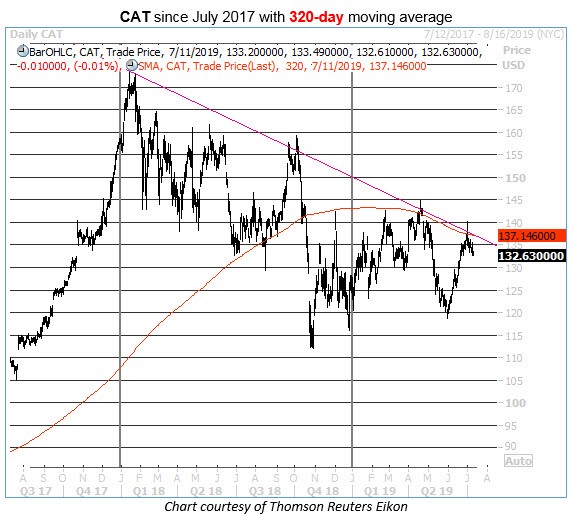Global trade wars and a weak technical outlook suggests a short for Caterpillar Inc, writes Elizabeth Harrow.
As a big-cap global producer of construction equipment, Dow component Caterpillar Inc. (CAT) has been one of the reliable major stock movers when there are headlines on the U.S.-China trade front. The shares rallied last Monday, July 1, after the G-20 sideline chat between Presidents Donald Trump and Chinese President Xi Jinping appeared to produce a tariff truce. But heading into the industrial giant's late-July quarterly earnings report, that minor bounce may simply present some late-to-the-party bears with yet another opportunity to get in on the long-term CAT decline.
Specifically, CAT peaked at $140.17 intraday on July 1, briefly crossing above its 320-day moving average in the process, but ultimately settling the day back below this long-term daily trendline (which hasn't been surmounted on a daily closing basis since April 23). The equity's encounter with this moving average may have appeared unremarkable, but Schaeffer's Senior Quantitative Analyst Rocky White reports that it's likely to signal extended weakness for Caterpillar stock over the month to come.

In the last three years, there have been five prior instances of CAT rallying up to test resistance at its 320-day moving average in this manner after an extended stretch trading below it, according to White. And following those previous five signals, the stock was down an average of 7.5% 21 days later, with 100% of those returns negative.
Coupled with CAT's recently troubling earnings history, the 320-day's spotless track record as a sell signal in recent years is alarming. With second-quarter results due out before the open on Wednesday, July 24, traders should note that Caterpillar shares have closed lower the day after earnings following each of the last five reports. Over that year-plus time frame, the equity's average single-session drop after earnings has amounted to a 5.6% slide.
Also adding pressure is the stock's 10% year-to-date return level, near the $140 level, which teamed up with the 320-day to reject last week's rally. The $135 area for CAT is not only the site of a 50% retracement of last October's steep sell-off, it's also home to a descending trendline connecting a string of lower highs dating back to the first quarter of 2018.
Meanwhile, following a 29.1% drop in short interest during the past two reporting periods, CAT is unlikely to catch a lift from continued short-covering activity in the weeks ahead. Short interest now accounts for just 1.6% of the equity's float, representing a relatively meager supply of sideline cash.
Elsewhere, CAT is still clinging to eight "buy" or better ratings, despite the stock's considerable underperformance. Any downgrades from these stubborn bullish holdouts could spark fresh selling, particularly if there's any hint of weakness in the upcoming earnings report.


















